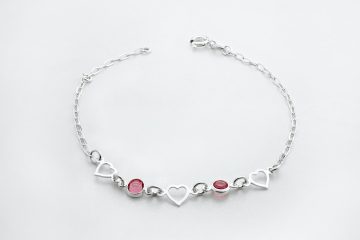Introduction
Bracelet making has become a popular hobby and craft for many individuals. Whether you are an amateur jewelry enthusiast or a professional designer, understanding the costs involved in bracelet making is essential. In this article, we will delve into the various factors that contribute to the price tag of creating bracelets. From materials and tools to labor and marketing, we will explore each aspect in detail, helping you gain a comprehensive understanding of the expenses associated with this craft.
Materials: The Building Blocks of Bracelets
When it comes to creating bracelets, the choice of materials plays a crucial role in determining the overall cost. The type of material used can vary widely, ranging from inexpensive beads and threads to more luxurious gemstones and precious metals. The cost of materials depends on factors such as quality, rarity, and availability.
Beads: A Spectrum of Options
Beads are a fundamental component of most bracelets, and their prices can vary greatly. Glass beads, plastic beads, and acrylic beads are often more affordable options, while semi-precious gemstone beads and freshwater pearls tend to be pricier. The quality, size, and uniqueness of the beads also contribute to their cost.
Threads and Cords: Strength and Style
The type of thread or cord used in bracelet making can have an impact on both the durability and aesthetics of the final product. Nylon threads and cotton cords are usually less expensive, while silk threads and leather cords can add a touch of luxury but may come at a higher cost. Additionally, specialized cords like elastic or memory wire can also increase the overall expenses.
Findings and Clasps: The Finishing Touches
Findings and clasps are essential components that secure the bracelet around the wrist. These can range from simple lobster clasps to intricate toggle clasps made of various metals. The material, design, and quality of the findings and clasps can significantly affect the price of the finished piece.
Tools: Equipping Yourself for Success
In addition to materials, having the right tools is essential for bracelet making. Investing in quality tools ensures precision and efficiency, but it also contributes to the overall cost of the craft.
Basic Tools: The Must-Haves
To create bracelets, you will need a set of basic tools such as needle-nose pliers, wire cutters, and round-nose pliers. These tools are essential for tasks like wire wrapping, creating loops, and attaching findings. While these tools are relatively affordable and can be reused for multiple projects, they are still a part of the initial investment.
Specialized Tools: Enhancing Your Craft
As you delve deeper into bracelet making, you may find the need for specialized tools to achieve specific techniques or designs. These tools can include bead boards, crimping pliers, and metal stamping kits. While these tools can elevate your creations, they may come at an additional cost.
Labor: Time is Money
Bracelet making requires time and effort, and it is important to consider the labor involved when calculating the overall cost. Whether you are creating bracelets for personal use or selling them, the time spent on each piece should be taken into account.
Design and Creation: The Artistic Process
Designing and creating a bracelet can be a time-consuming task, especially if you are incorporating intricate patterns or complex techniques. The more time and effort invested in the creation process, the higher the value of the bracelet.
Assembly and Finishing: Attention to Detail
Once the design is finalized, the assembly and finishing stages require careful attention to detail. This includes tasks such as stringing beads, attaching findings, and ensuring the bracelet’s quality. The labor involved in these steps adds value to the final product.
Customization and Personalization: Catering to Individual Tastes
If you offer customization options for your bracelets, additional labor is required to cater to the specific preferences of each customer. This can include selecting personalized charms, arranging beads in a specific order, or incorporating birthstones. While customization increases the price, it also adds uniqueness and value to the bracelet.
Marketing: Spreading the Word
If you plan to sell your bracelets, marketing costs should be taken into consideration. Successfully promoting your creations requires various strategies and channels, each with its own expenses.
Online Presence: The Digital Marketplace
Creating a website, setting up an online store, or utilizing e-commerce platforms can incur costs such as domain registration, hosting fees, and transaction fees. Additionally, investing in professional product photography and engaging copywriting can enhance the online presence of your bracelets, attracting potential customers.
Social Media and Advertising: Reaching a Wider Audience
Utilizing social media platforms like Instagram, Facebook, and Pinterest can be effective for showcasing your bracelets and connecting with potential buyers. However, running paid advertisements or sponsored posts can incur costs that contribute to the overall marketing expenses.
Packaging and Branding: Leaving a Lasting Impression
Presenting your bracelets in attractive packaging can elevate the perceived value of your creations. Investing in custom packaging materials, labels, and business cards can give your brand a professional touch. These costs should be factored into the overall price of the bracelets.
Conclusion
Creating bracelets is not just a creative outlet but also a craft that involves various costs. From materials and tools to labor and marketing, each aspect contributes to the final price. By considering these factors, you can gain a comprehensive understanding of the expenses involved in bracelet making. Whether you are creating bracelets as a hobby or for commercial purposes, understanding the costs can help you make informed decisions and ensure a sustainable and profitable venture.
FAQs (Frequently Asked Questions)
1. Is bracelet making an expensive hobby?
Bracelet making can be as affordable or as expensive as you make it. The cost depends on factors such as the materials used, the complexity of the design, and the tools required. By choosing budget-friendly options and starting with basic techniques, you can enjoy bracelet making without breaking the bank.
2. Can I sell handmade bracelets at a reasonable price?
Yes, you can sell handmade bracelets at a reasonable price while still making a profit. It is important to consider the costs involved, including materials, labor, and marketing. Researching the market, finding your niche, and offering unique designs can help you create a pricing strategy that is fair to both you and your customers.
3. How can I reduce the costs of bracelet making?
There are several ways to reduce the costs of bracelet making. You can consider buying materials in bulk, sourcing affordable alternatives for expensive components, and reusing tools for multiple projects. Additionally, exploring cost-effective marketing strategies and utilizing social media platforms can help minimize expenses.
4. Can I make personalized bracelets without increasing the price significantly?
Yes, you can offer personalized bracelets without significantly increasing the price. By streamlining your customization process and offering limited options, you can efficiently cater to individual preferences while keeping the additional labor and material costs at a manageable level.
5. Are there any hidden costs I should be aware of in bracelet making?
While we have covered the main costs involved in bracelet making, it is important to consider additional expenses that may arise. These can include shipping costs, fees for online marketplaces, and unexpected fluctuations in the price of materials. Keeping a buffer for unforeseen expenses can help you navigate any hidden costs that may arise.




